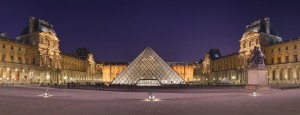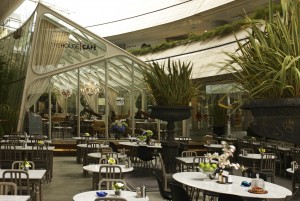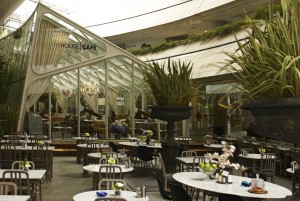The introduction of the glass curtain-walled building in 1908 made a huge impact on the architectural industry. While “steel with glass construction” buildings didn’t immediately take off and were even perceived by some as ugly, the limits on an architect’s ability to incorporate large panes of glass into the design of a building are still being pushed today.
The Louvre Pyramid
 Designed by Chinese architect I.M. Pei, one of the most widely recognized glass-and-steel structures in the world is the Louvre Pyramid, located in Paris, France. It was completed in 1989 and serves as the main entrance to the Louvre Museum, home of the Mona Lisa portrait. The modern glass pyramid structure sits in sharp contrast to its surrounding classical stone architecture. While the exact number of glass panes has been disputed, the Louvre Museum states there are 673 individual panes.
Designed by Chinese architect I.M. Pei, one of the most widely recognized glass-and-steel structures in the world is the Louvre Pyramid, located in Paris, France. It was completed in 1989 and serves as the main entrance to the Louvre Museum, home of the Mona Lisa portrait. The modern glass pyramid structure sits in sharp contrast to its surrounding classical stone architecture. While the exact number of glass panes has been disputed, the Louvre Museum states there are 673 individual panes.
Troll Wall Restaurant and Visitor Center
The Louvre Pyramid isn’t the only glass and steel building designed to intentionally juxtapose its existing surroundings. Designed by Reiulf Ramstad Architects, the Troll Wall Restaurant and Visitor Center, located in Norway, sits at the base of the mountainous Troll Wall cliff. The restaurant and visitor center is covered entirely with mirrored glass panes which enable it to blend in with the surroundings when the sunlight reflects at the right angle.
Glass Skywalks
Glass-and-steel construction has also been used to push vertical limits, providing breathtaking views, and testing the fear threshold of visitors around the world. Arizona’s Grand Canyon, the Willis Tower in Chicago, Illinois, and even the Eiffel Tower in Paris, France have been among the growing list of locations outfitted with glass skywalks. Ranging from 187 – 1,000 feet above ground, these architectural masterpieces are all comprised of a series of laminated glass panes. The lamination of individual panes helps to provide the strength and durability needed to withstand an 8.0 earthquake or the weight of about 71 fully-loaded 747 jets.
The House Kafe Kanyon
 The concept of glass-and-steel construction has also been used to define space. The House Kafe Kanyon located in the Kanyon shopping mall in Istanbul, Turkey provides a high-end dining experience atop a raised walnut floor designed to bring warmth to the structure. Retrofitted into the existing mall space, the asymmetrical transparent box marries the existing mall design with the brand identity of The House Kafe.
The concept of glass-and-steel construction has also been used to define space. The House Kafe Kanyon located in the Kanyon shopping mall in Istanbul, Turkey provides a high-end dining experience atop a raised walnut floor designed to bring warmth to the structure. Retrofitted into the existing mall space, the asymmetrical transparent box marries the existing mall design with the brand identity of The House Kafe.
The strength and durability of glass-and-steel construction has enabled architects to define and create aesthetically beautiful spaces. Using these same materials, Total Security Solutions works with architects to design beautifully secure entryways and customer contact points. If you’re ready to speak with one of our knowledgeable sales staff or need a second set of eyes on your contract documents, give us a call at 800.513.1468.
NEXT STEPS:
- Schedule a free bulletproof glass project design spec review
- Visit our blog for the latest industry news
- Follow us on Twitter, Facebook or LinkedIn
Images courtesy of wikipedia.org and commons.wikimedia.org


